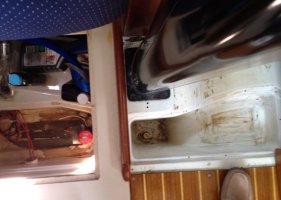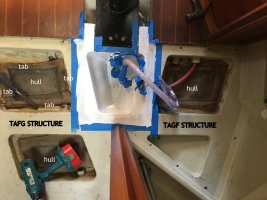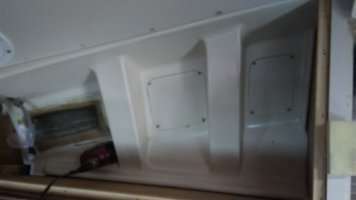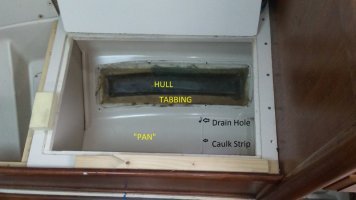It's rained over 5" in the last 5 days in Tacoma, WA. When I checked on the boat yesterday I was greeted by 1/2" of standing water on the cabin sole in front of the stove and galley sink. I had time for a little more investigating today:
It first appeared that water was coming from under the teak cabinet front-wall below the stove. I was going to remove the stove today, but I first removed the tilt-out cabinet drawer forward of the stove. Under this cabinet is a flat gelcoat surface with a slightly recessed "pan" maybe 1/2" deep. The pan was full of water and the excess was flowing aft, under the stove. So, I kept working forward towards the bow. The next section is the under-settee storage locker. Again, a flat gelcoat surface with a slightly recessed "pan" about 1/2" deep. And yes, this pan was full of water, too. Moving forward still, the next section is the starboard water-tank compartment. I didn't get this far today without my drill-driver to remove the 16-or-so screws holding the cover plate above the water tank.
Don't know what I'll find tomorrow, and I realize I still may be several feet away from the source of the leak (maybe a stanchion base or genoa car track up on deck????), but my question is this:
Can I drill small (say 1/4 - 5/16") drain holes into the "pans" below the setee storage locker and the tilt-out cabinet. Drain holes would (I'm assuming) allow the water to find it's way to the bilge rather than onto the wooden sole. I can hear from tapping with my knuckle that it is hollow below most of the pan areas. I drilled a smaller pilot hole (3/32") in one of the pan areas and found at least 1 1/2" (the length of the bit) of dead space below the thin fiberglass surface of the pan.
All of this makes me think I'm okay to drill drain holes in these areas. Has anyone else tried this???????
Thanks,
Ken
It first appeared that water was coming from under the teak cabinet front-wall below the stove. I was going to remove the stove today, but I first removed the tilt-out cabinet drawer forward of the stove. Under this cabinet is a flat gelcoat surface with a slightly recessed "pan" maybe 1/2" deep. The pan was full of water and the excess was flowing aft, under the stove. So, I kept working forward towards the bow. The next section is the under-settee storage locker. Again, a flat gelcoat surface with a slightly recessed "pan" about 1/2" deep. And yes, this pan was full of water, too. Moving forward still, the next section is the starboard water-tank compartment. I didn't get this far today without my drill-driver to remove the 16-or-so screws holding the cover plate above the water tank.
Don't know what I'll find tomorrow, and I realize I still may be several feet away from the source of the leak (maybe a stanchion base or genoa car track up on deck????), but my question is this:
Can I drill small (say 1/4 - 5/16") drain holes into the "pans" below the setee storage locker and the tilt-out cabinet. Drain holes would (I'm assuming) allow the water to find it's way to the bilge rather than onto the wooden sole. I can hear from tapping with my knuckle that it is hollow below most of the pan areas. I drilled a smaller pilot hole (3/32") in one of the pan areas and found at least 1 1/2" (the length of the bit) of dead space below the thin fiberglass surface of the pan.
All of this makes me think I'm okay to drill drain holes in these areas. Has anyone else tried this???????
Thanks,
Ken
Last edited by a moderator:




